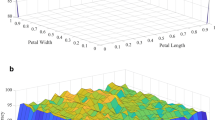Abstract
Sequential forward floating search (SFFS) has been well recognized as one of the best feature selection methods. This paper proposes a filter-dominating hybrid SFFS method, aiming at high efficiency and insignificant accuracy sacrifice for high-dimensional feature subset selection. Experiments with this new hybrid approach have been conducted on five feature data sets, with different combinations of classifier and separability index as alternative criteria for evaluating the performance of potential feature subsets. The classifiers under consideration include linear discriminate analysis classifier, support vector machine, and K-nearest neighbors classifier, and the separability indexes include the Davies-Bouldin index and a mutual information based index. Experimental results have demonstrated the advantages and usefulness of the proposed method in high-dimensional feature subset selection.






Similar content being viewed by others
Notes
The challenge itself contains EEG signals from 7 subjects, recorded during synchronous BCI experiments. Three subjects are synthesized, thus we used only the data recorded from 4 human subjects.
References
Liu H, Yu L (2005) Toward integrating feature selection algorithms for classification and clustering. IEEE Trans Knowl Data Eng 17(4):491–502
Gan JQ (2006) Feature dimensionality reduction by manifold learning in brain-computer interface design. In: 3rd international workshop on brain-computer interfaces. Graz, Austria, pp 28–29
Gheyas IA, Smith LS (2010) Feature subset selection in large dimensionality domains. Pattern Recogn 43(1):5–13
Awwad Shiekh Hasan B, Gan JQ, Zhang Q (2010) Multi-objective evolutionary methods for channel selection in brain-computer interfaces: some preliminary experimental results. In: IEEE congress on evolutionary computation. Barcelona, Spain, pp 3339–3344
Tong DL, Mintram R (2010) Genetic algorithm-neural network (GANN): a study of neural network activation functions and depth of genetic algorithm search applied to feature selection. Int J Mach Learn Cybern 1(1–4):75–87
Boehm O, Hardoon DR, Manevitz LM (2011) Classifying cognitive states of brain activity via one-class neural networks with feature selection by genetic algorithms. Int J Mach Learn Cybern 2(3):125–134
Davies JL, Bouldin DW (1979) A cluster separation measure. IEEE Trans Pattern Anal Mach Intell 1:224–227
Bezdek JC, Pal NR (1998) Some new indexes of cluster validity. IEEE Trans SMC-Part B 28(3):301–315
Peng H, Long F, Ding C (2005) Feature selection based on mutual information: criteria of max-dependency, max-relevance, and min-redundancy. IEEE Trans Pattern Anal Mach Intell 27(8):1226–1238
Handl J, Knowles J (2006) Feature subset selection in unsupervised learning via multiobjective optimization. Int J Comput Intell Res 2(3):217–238
Das S (2001) Filters, wrappers and a boosting-based hybrid for feature selection. In: Proceedings 18th international conference on machine learning, pp 74–81
Sebban M, Nock R (2002) A hybrid filter/wrapper approach of feature selection using information theory. Pattern Recogn 35:835–846
Somol P, Novovocova J, Pudil P (2006) Flexible-hybrid sequential floating search in statistical feature selection. In: Lecture notes in computer science, vol 4109. Springer, Berlin, pp 632–639
Huang J, Cai Y, Xu X (2007) A hybrid genetic algorithm for feature selection wrapper based on mutual information. Pattern Recogn Lett 28(13):1825–1844
Uncu O, Turksen IB (2007) A novel feature selection approach: combining feature wrappers and filters. Inf Sci 177:449–466
Bermejo P, Gamez JA, Puerta JM (2011) A GRASP algorithm for fast hybrid (filter-wrapper) feature subset selection in high-dimensional datasets. Pattern Recogn Lett 32(5):701–711
Pudil P, Novovicova J, Kittler J (1994) Floating search methods in feature selection. Pattern Recogn Lett 15:1119–1125
Jain A, Zongker D (1997) Feature selection: evaluation, application, and small sample performance. IEEE Trans Pattern Anal Mach Intell 19(2):153–158
Dyson M, Balli T, Gan JQ, Sepulveda F, Palaniappan R (2008) Approximate entropy for EEG-based movement detection. In: 4th international workshop on brain-computer interfaces, Graz, Austria, pp 110–115
Blankertz B, Dornhege G, Krauledat M, Mller K, Curio G (2007) The non-invasive berlin brain-computer interface: fast acquisition of effective performance in untrained subjects. NeuroImage 37:539–550
Desmar J (2006) Statistical comparisons of classifiers over multiple data sets. J Mach Learn Res 7:1–30
Author information
Authors and Affiliations
Corresponding author
Rights and permissions
About this article
Cite this article
Gan, J.Q., Awwad Shiekh Hasan, B. & Tsui, C.S.L. A filter-dominating hybrid sequential forward floating search method for feature subset selection in high-dimensional space. Int. J. Mach. Learn. & Cyber. 5, 413–423 (2014). https://doi.org/10.1007/s13042-012-0139-z
Received:
Accepted:
Published:
Issue Date:
DOI: https://doi.org/10.1007/s13042-012-0139-z




